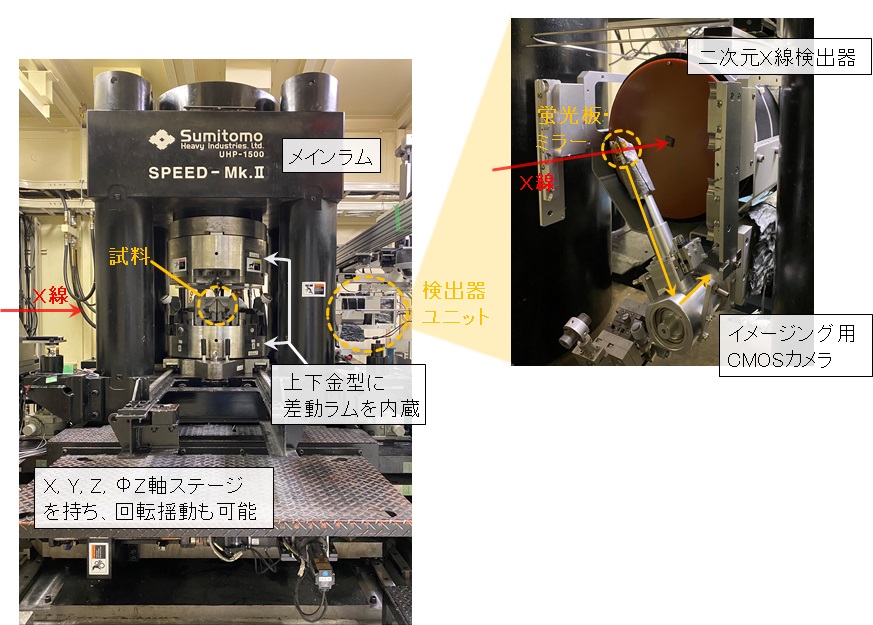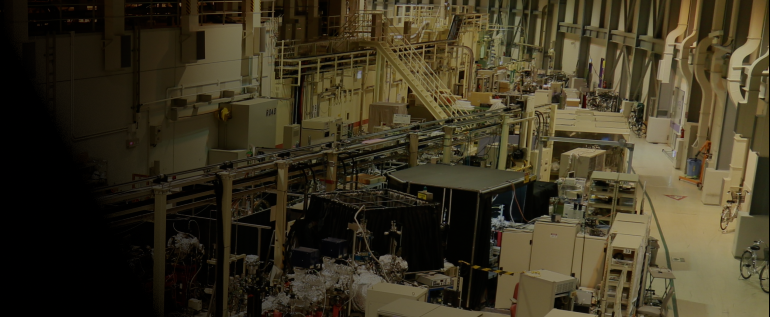変形機構付き大容量高圧発生装置(SPEED-MkⅡ)
◆装置概要
大容量試料(~mm3)を最大100 GPaまで加圧&加熱できます。更に、メインラムに加えて、ガイドブロック内に変形用のサブラムを備えており、高圧下での変形実験が可能です。

◆装置の特徴
本システムは、比較的大型の試料(~mm3)を多軸圧縮で準静水圧環境下に晒すことができます。また、高圧セル内部の抵抗ヒーターで安定的に加熱できることから、高圧新奇物質のその場合成に適しています。本装置では高圧高温状態の試料に白色X線をそのまま照射して、X線吸収像の観察やエネルギー分散型XRD測定をおこなえ、更に高エネルギー単色X線を利用した角度分散型XRD計測も可能です。高圧プレス
本装置は2段押しの川井型高圧発生装置であり、最大1500トンの荷重を試料に加えることができます。本装置はメインラムに加えて、最大300トンの変形用ラムが内蔵されており、メインラムによる準静水圧加圧の後に、変形ラムによる1軸圧縮変形が可能です。また、本装置はアンビル面間距離の精度が高く焼結ダイヤモンドアンビルを使用して最大100GPa程度の高圧発生が可能です。高圧セル内部に抵抗加熱式ヒーターを組み込むことで3000℃までの加熱が可能です。
X線ビームモニター
X線吸収像の観察には浜松ホトニクス製のX線ビームモニターを使用しています。GAGG蛍光板で可視光に変換し、汎用のカメラ用光学レンズで結像します。カメラは同じく浜松ホトニクス製の科学計測用のsCMOSカメラを使用しています。見かけの分解能は約3μm/pixとなります。
Ge-SSD
XRD計測にはエネルギー分散型のX線回折法を採用してします。回折X線のエネルギースペクトル測定にはミリオンテクノロジーズ・キャンベラ社製のGe-SSDを常設しており、測定可能なエネルギー範囲は10~150keVです。
大面積2次元検出器
高エネルギー単色X線(エネルギー ~61keV)を利用した角度分散型X線回折測定ではRayonix社製の大面積CCD検出器を使用して、デバイリングを全周取得できます。特に、高圧変形実験で試料に加わる歪や応力測定に威力を発揮します。
◆装置アクセサリー
上記の高圧プレスで加熱するための、交流電源(2kW)と直流電源(1.5kW×3)を備えており、小型ヒーターに大電流(~300A)を印可して試料を数千度まで加熱できます。これらのX線計測機器の他に、試料の弾性波速度(弾性率)を測定するための超音波エコー測定システムや、4端子法で電気抵抗測定が可能なデジタルマルチメーターを利用できます。
◆実験・試料準備
基本的に一段目アンビルには一辺50mmと27mmの超硬合金製アンビルを使用し、二段目アンビルには一辺26mmと14mmの超硬製アンビルまたは、焼結ダイヤモンド製アンビルを使用できる他に、6-6加圧用ガイドフレームが利用でき、手軽に一段加圧用の立方形の圧力媒体が使用できます。角度分散型X線回折実験にはコーン型の切り込み付きの一段目アンビルを使用して、2θ=10°までの回折角のデータが取得できるが、デバイリングを全周取得するためには、コーン型の切り込み付きの二段目アンビル、またはX線の透過性に優れたc-BN製アンビル等を特別に用意しなければなりません。
◆実験手順・注意事項
実験手順の詳細はBL担当者にお聞きください。
一般的な実験手順として、
(1)高圧セル、試料準備
希望する圧力・温度・酸素雰囲気等により高圧セルを設計、パーツを製作する。試料は粉体のペレットもしくは焼結体を用意する。
(2)装置校正
Ge-SSDのエネルギー校正、水平ゴニオメーターの2θ補正をおこなう。
(3)高圧セル設置&常圧測定
加圧前の試料の状態をX線ラジオグラフィーで確認し、XRDデータを取得する。常圧データはその後の高圧データを定量的に議論する際に非常に重要であり、圧力の計算にも欠かせない。
(4)加圧&圧力測定
大型プレスで高圧セルを加圧する。通常3~5ton/minでゆっくり加圧する。加圧中に高圧セル内の圧力標準物質のXRD測定によって得られる結晶格子の縮みから発生圧力を計算し、目標圧力に達するまで、加圧&圧力測定を繰り返す。通常数時間はかかる。
(5)加熱&データ測定
目標圧力に達した後に、内部ヒーターによる加熱を開始する。加圧によるヒーター変形があるため、ヒーターの安定性に注視しつつ、目標温度まで加熱する。昇温しつつ試料のXRDデータを取得して、相変化や格子定数変化をその場観察する。圧力―温度平面上で多数のデータを取得する場合は(4)~(5)を繰り返す。
チェ―ブロックによる高圧セルの設置の際や、大型プレスの操作時は重大事故につながる恐れがあるため、特に注意が必要です。
また、白色X線は照射物を著しく損傷させます。X線の軸上に不用意にケーブルや検出器等を設置しないようにお願いします。
◆問い合わせ先
肥後祐司 このメールアドレスはスパムボットから保護されています。閲覧するにはJavaScriptを有効にする必要があります。
丹下慶範 このメールアドレスはスパムボットから保護されています。閲覧するにはJavaScriptを有効にする必要があります。
◆代表的な論文リスト
Sharp 660-km discontinuity controlled by extremely narrow binary post-spinel transition
Takayuki Ishii, Rong Huang, Robert Myhill, Hongzhan Fei, Iuliia Koemets, Zhaodong Liu, Fumiya Maeda, Liang Yuan, Lin Wang, Dmitry Druzhbin, Takafumi Yamamoto, Shrikant Bhat, Robert Farla, Takaaki Kawazoe, Noriyoshi Tsujino, Eleonora Kulik, Yuji Higo, Yoshinori Tange & Tomoo Katsura
Nature Geoscience 23 Sep. 2019:
Vol. 12, pp. 869-872
DOI: 10.1038/s41561-019-0452-1
Intermediate-depth earthquakes linked to localized heating in dunite and harzburgite
Tomohiro Ohuchi, Xinglin Lei, Hiroaki Ohfuji, Yuji Higo, Yoshinori Tange, Takeshi Sakai, Kiyoshi Fujino & Tetsuo Irifune
Nature Geoscience 28 Aug. 2017:
Vol. 10, pp. 771-776
DOI: 10.1038/ngeo3011
Mantle dynamics inferred from the crystallographic preferred orientation of bridgmanite
Noriyoshi Tsujino, Yu Nishihara, Daisuke Yamazaki, Yusuke Seto, Yuji Higo & Eiichi Takahashi
Nature 17 Mar 2016:
Vol. 539, pp. 81-84
DOI: 10.1038/nature19777
Stability of hydrous silicate at high pressures and water transport to the deep lower mantle
M. Nishi, T. Irifune, J. Tsuchiya, Y. Tange, Y. Nishihara, K. Fujino & Y. Higo
Nature Geoscience 02 Feb. 2014:
Vol. 7, pp. 224-227
DOI: 10.1038/ngeo2074
P-V-T equation of state for ε-iron up to 80 GPa and 1900 K using the Kawai-type high pressure apparatus equipped with sintered diamond anvils
Daisuke Yamazaki, Eiji Ito, Takashi Yoshino, Akira Yoneda, Xinzhuan Guo, Baohua Zhang, Wei Sun, Akira Shimojuku, Noriyoshi Tsujino, Takehiro Kunimoto, Yuji Higo, Ken Ichi Funakoshi
Geophysical Research Letters 28 Oct. 2012
Vol. 39, no. 20. pp. 20308-
DOI: 10.1029/2012GL053540
Large Capacity, High-Pressure Generating Equipment with Transformation Mechanisms (SPEED-Mk II)
◆Equipment overview
Large capacity samples(~mm3)can be pressurized and heated up to 100GPa. In addition to the main ram, a sub-ram is provided for transformation in the guide block, allowing transformation experiments under high pressure.

◆Features of the Equipment
This system can expose relatively large-sized samples(~mm3)to multi-axis compression in a quasi-hydrostatic environment. Also, since it can be heated stably with a resistance heater inside a high-pressure cell, it is suited for cases of high-pressure substances. With this equipment, samples in high-temperature, high-pressure states can be irradiated with white X-rays, to observe X-ray absorption images, perform energy distribution XRD measurements, and even angle distribution XRD measurements using high-energy monochromatic X-rays.High-Pressure Press
This equipment is a 2-stage, Kawai-type high pressure generator that can apply loads up to 1,500 tons per sample. In addition to the main ram, there is a built-in transformation ram that is capable of applying a load of 300 tons, and after the main ram pressurizes to quasi-hydrostatic pressure, single axis compression transformation is possible by the transformation ram. Also, this equipment has a high precision distance between the anvil surfaces, and high pressures of up to 100GPa can be generated using a sintered diamond anvil. By incorporating a resistance heater inside the high-pressure cell, it is possible to heat to 3000℃.
X-ray Beam Monitor
X-ray absorption images are observed using an X-ray beam monitor manufactured by Hanamatsu Photonics. It is converted to visible light using a GAGG fluorescent plate, then imaged with a general-purpose optical camera lens. The camera used for scientific measurements is a sCMOS camera, also manufactured by Hanamatsu Photonics. The effective resolution is approximately 3μm/pix.
Ge-SSD
XRD measurement uses energy-dispersive X-ray diffraction. Measurements of the X-ray diffraction energy spectrum are completed using a permanently installed Ge-SSD manufactured by Mirion Technologies (Canberra), with a measurable energy range of 10~150keV.
Large Area 2-Dimensional Detector
For angular transformation X-ray diffraction measurements using high-energy, monochromatic X-rays (energy ~61keV), the Debye-Scherrer ring can be obtained using a large-area CCD detector manufactured by Rayonix. In particular, it is effective for strain and stress measurements applied to high-pressure transformation experiments.
◆Equipment accessories
For heating with the above high-pressure press, an AC power supply of (2kW) and a DC power supply of(1.5kW×3)is equipped, a large current(~300A)can be applied to a small heater to heat the sample to several thousand degrees.
In addition to these X-ray measurement instruments, there is an ultrasound echo measurement system used to measure the elastic wave velocity (modulus of elasticity) of the sample, as well as a four-terminal digital multimeter to measure electric resistance.
◆Experiment / sample preparation
For the first stage, a 50mm by 27mm carbide anvil is used, and for the second stage a 26mm by 14mm carbide anvil is used. In addition, a sintered diamond anvil can also be used, as well as a 6-6 guide frame for pressurization, making it easy to use standard pressure mediums for pressurizations. For angle dispersion X-ray diffraction experiments, a cone-shaped, first-stage anvil is used allowing for 2θ=10°diffraction data to be acquired. In order to obtain the entire rotation of the Debye-Scherrer ring, a cone-shaped anvil is used at the second-stage, also a c-BN anvil which has excellent X-ray transparency must be specially prepared.
◆Experimental procedure / precautions
For details on experimental procedures, please ask the person in charge of the BL.
General experimental procedure,
(1)High Pressure Cell, Sample Preparation
High-pressure cells are designed and created depending on the desired pressure, temperature, oxygen atmosphere, etc. The sample is prepared using powdered pellets or sintered bodies.
(2)Instrument Calibration
Ge-SSD energy calibrations and 2θ goniometer calibrations are performed.
(3)High-Pressure Cell Installation and Standard Pressure Measurements
The state of the sample before pressurization is confirmed by X-ray radiography, then XRD data can be acquired. The constant pressure data is significant for quantitative discussions of high-pressure data, and is essential for computing pressure.
(4)Increasing Pressure & Pressure Measurements
The high-pressure cell can be pressurized with the large press. It usually takes 3~5ton/min to slowly pressurize. During pressurization, the generated pressure is calculated from the shrinking of the crystal lattice structure, obtained by XRD measurements of the high-pressure cell inside the substance. The pressurization and pressure measurements are repeated until the target pressure is reached, which usually takes several hours.
(5)Heating & Data Measurements
After reaching the target pressure, heating is started with an internal heater. Since there is a heater transformation due to pressurization, it must be heated to the target temperature while the stability of the heater is carefully observed. The XRD data of the sample is acquired while the temperature rises, and phase changes as well as lattice changes are observed.
Repeat (4) ~ (5) when a large amount of data is acquired on the pressure – temperature plane.
Special care must be paid to the installation of high-pressure cells with chain blocks, as well as when operating large presses, as this may lead to serious accidents.
Also, white X-rays significantly damage whatever they irradiate. Please no not install cables, detectors, etx on the X-ray axis.
◆Contact
肥後祐司 このメールアドレスはスパムボットから保護されています。閲覧するにはJavaScriptを有効にする必要があります。
丹下慶範 このメールアドレスはスパムボットから保護されています。閲覧するにはJavaScriptを有効にする必要があります。
◆List of representative treatises
Sharp 660-km discontinuity controlled by extremely narrow binary post-spinel transition
Takayuki Ishii, Rong Huang, Robert Myhill, Hongzhan Fei, Iuliia Koemets, Zhaodong Liu, Fumiya Maeda, Liang Yuan, Lin Wang, Dmitry Druzhbin, Takafumi Yamamoto, Shrikant Bhat, Robert Farla, Takaaki Kawazoe, Noriyoshi Tsujino, Eleonora Kulik, Yuji Higo, Yoshinori Tange & Tomoo Katsura
Nature Geoscience 23 Sep. 2019:
Vol. 12, pp. 869-872
DOI: 10.1038/s41561-019-0452-1
Intermediate-depth earthquakes linked to localized heating in dunite and harzburgite
Tomohiro Ohuchi, Xinglin Lei, Hiroaki Ohfuji, Yuji Higo, Yoshinori Tange, Takeshi Sakai, Kiyoshi Fujino & Tetsuo Irifune
Nature Geoscience 28 Aug. 2017:
Vol. 10, pp. 771-776
DOI: 10.1038/ngeo3011
Mantle dynamics inferred from the crystallographic preferred orientation of bridgmanite
Noriyoshi Tsujino, Yu Nishihara, Daisuke Yamazaki, Yusuke Seto, Yuji Higo & Eiichi Takahashi
Nature 17 Mar 2016:
Vol. 539, pp. 81-84
DOI: 10.1038/nature19777
Stability of hydrous silicate at high pressures and water transport to the deep lower mantle
M. Nishi, T. Irifune, J. Tsuchiya, Y. Tange, Y. Nishihara, K. Fujino & Y. Higo
Nature Geoscience 02 Feb. 2014:
Vol. 7, pp. 224-227
DOI: 10.1038/ngeo2074
P-V-T equation of state for ε-iron up to 80 GPa and 1900 K using the Kawai-type high pressure apparatus equipped with sintered diamond anvils
Daisuke Yamazaki, Eiji Ito, Takashi Yoshino, Akira Yoneda, Xinzhuan Guo, Baohua Zhang, Wei Sun, Akira Shimojuku, Noriyoshi Tsujino, Takehiro Kunimoto, Yuji Higo, Ken Ichi Funakoshi
Geophysical Research Letters 28 Oct. 2012
Vol. 39, no. 20. pp. 20308-
DOI: 10.1029/2012GL053540
